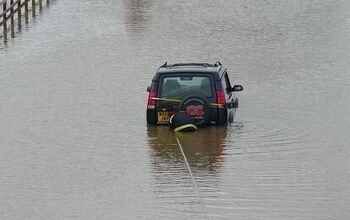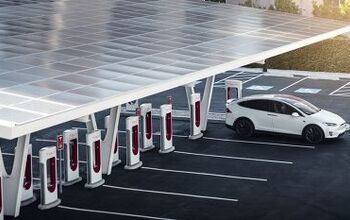32 Views
Piston Slap: Don't Jump to Conclusions!

by
Sajeev Mehta
(IC: employee)
Published: January 4th, 2019
Share
TTAC commentator Towncar writes:
I just recently had a dead battery on the Town Car, so learning how to properly jump start a car battery has been on my mind. I’m telling you, there’s a lot to say on this subject once you get into it!
- Do you really have to put the negative clamp on some exposed part of the cars body, which will probably be inconveniently located and totally greasy, when the negative battery terminal is sitting right there, handy and probably clean enough to make contact?
- What about those things that are supposed to plug into the cigarette lighter and give you a jump that way — will they work or burn the car down?
- And those little pocket-size jump boxes — any good?
- Can you damage the electronics in a modern car with a jump? (Assuming you don’t reverse the clamps.)
- And have you seen those plugs they have in the grilles of some service vehicles — they just stick in a cord, the other end has clamps, and there you are. Why doesn’t every vehicle have a plug like that? A plug-to-plug connection would get around the whole clamp business anyway.
- Or why don’t cars just have two batteries?
- Or why don’t they all have battery run down protectors? Should you install one of those protector things if your car doesn’t have it?
Sajeev answers:
Talk about a loaded query! Let’s do this thing:
- Yes because a spark can ignite a de-gassing battery. Granted I am SUPER GUILTY of this, but after a bit of Googling I learned my lesson. And all batteries vent, no matter the design? If you don’t have a clean ground, clean your engine and check the condition of your negative battery cable/grounds…killing multiple birds with two stones.
- I assume they work, just not with the speed you’d expect. Backfeeding juice is limited by the wire/fuse size, but hey, if I can backfeed power to a hurricane-damaged house with a gas generator wired via the dryer connection…why not?
- See #2
- Possibly but not likely: that’s what fuses (and fusible links, if equipped) are for.
- Cars are too expensive and littered with fail points as it is: no thank you!
- See #5 and keep in mind that many modern, fuel/emissions efficient sports sedans weigh not much less than your rather simple Town Car.
- Run down protectors are a good idea, but I’d never spend the money or time to install one on an older vehicle. That’s what jumper cables in the trunk are for.
Final thoughts, Best and Brightest?
[Image: Ford]
Send your queries to sajeev@thetruthaboutcars.com. Spare no details and ask for a speedy resolution if you’re in a hurry…but be realistic, and use your make/model specific forums instead of TTAC for more timely advice.
#CarBattery
#CigaretteLighter
#GroundingPoint
#HowToProperlyJumpStartACarBattery
#JumpStart
#NegativeTerminal

Sajeev Mehta
More by Sajeev Mehta
Published January 4th, 2019 8:00 AM
Latest Car Reviews
Read moreLatest Product Reviews
Read moreRecent Comments
- Spectator Wild to me the US sent like $100B overseas for other peoples wars while we clammer over .1% of that money being used to promote EVs in our country.
- Spectator got a pic of that 27 inch screen? That sounds massive!
- MaintenanceCosts "And with ANY car, always budget for maintenance."The question is whether you have to budget a thousand bucks (or euro) a year, or a quarter of your income.
- FreedMike The NASCAR race was a dandy. That finish…
- EBFlex It’s ironic that the typical low IQ big government simps are all over this yet we’re completely silent when oil companies took massive losses during Covid. Funny how that’s fine but profits aren’t. These people have no idea how business works.


































Comments
Join the conversation
My portable generator has a battery charger built in. But that's a little big to carry around in a car. Just went to pull the Tahoe out of the garage tonight and the battery was completely dead. Think it hasn't moved for 3-4 weeks. I just put a battery charger on it for an hour or so to get it started. That's better/safer/easier than jumping it, just takes longer which no big deal if you got the time. Plus no way I'd jump it with the Volt. It may be OK but I'm not about to test the waters and find out!....LOL
I have a VW Phaeton. These all came with a dual battery setup -- one for Starting and the other for Electronics, on either side of the trunk. Power is needed from both batteries to start the car, as the Electronics battery supplies the ECU. So if the first starting attempt fails to turn the engine over due to weak batteries, the car will automatically parallel the batteries during the driver's second attempt to ensure sufficient power to start. So far, this has never failed to work even after months of idle time. In case both batteries are too weak to jump start the car, a chassis ground point and remote battery terminal post are provided under the hood. However, *why* is connecting to a chassis ground point safer than connecting to the weak battery's negative terminal? Is there a lower chance of sparks? If so, why? Seems to me a chassis ground connection could still cause a very weak battery to explode as pwrwrench has described? Secondly, every jumper cable clamp I've seen has serrated copper jaws. But even with the best of intentions, only a couple of the copper points touch the battery nut. They don't even manage to grab onto the actual metal battery post but only some nut on the connector attached to the post. Seems to me this will have very high electrical resistance and impede the 100s of amps needed during a jump start. And that should only get worse when connected to a chassis ground that is even further away from the battery post.